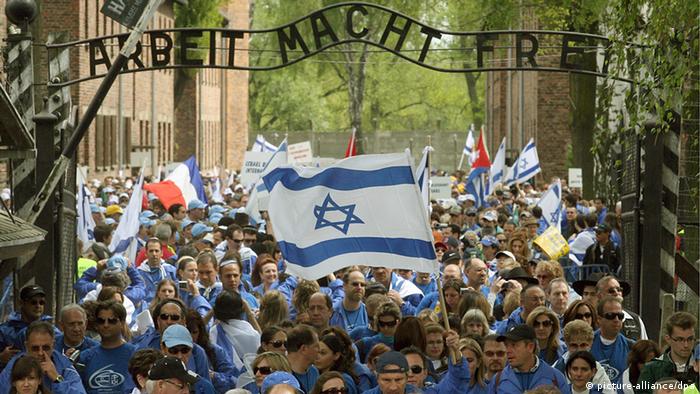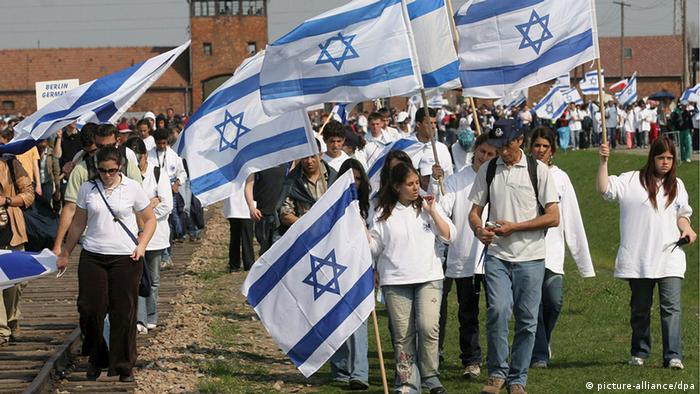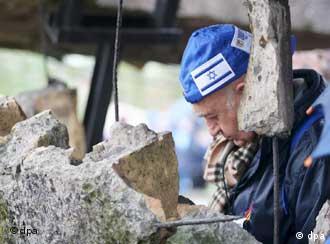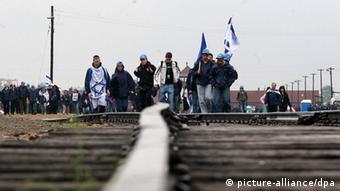The "March of the Living" teaches students from all over the world about the Holocaust. For 25 years, contemporary witnesses and youths commemorate the victims by walking along the route of the former Nazi death march.
It's a three-kilometer walk (1.9 miles) from the Auschwitz concentration camp to Birkenau where people were systematically killed by the Nazis during World War II. In April 1988, masses of people were flocking the narrow street. More than 14,000 young Jews from all over the world had come together to march down the same path the Nazi victims had to walk on.
OnYom HaShoah, the Israeli Holocaust Remembrance Day, they were joined by survivors of the Holocaust, or Shoa, who had decided to return to the place of martyrdom to commemorate the victims. But they also wanted to look ahead and move forward.
Since that first march in April, the "March of the Living" takes places on every Yom HaShoah. The event stands in stark contrast to the Nazi's death marches, explained Shmuel Rosenman, the 69-year-old Israeli who heads the organization "March of the Living International" and is one of the initiative's founders.
The death marches stand for a cruel chapter in German history: In the last months of World War II, the Nazis cleared out their concentration camps in Poland and sent thousands of starved prisoners on back-breaking marches to Germany. Many of them didn't survive the freezing temperatures.
Today's "March of the Living" is a "sign of hope," Rosenman said. The silent march - with many young participants - is a symbol of the future.
Breaking the silence
This year's march on Monday (08.04.2013) marks the event's 25th anniversary. More than 150,000 people have participated in the past years.
"The initial idea was to teach teenagers about the Shoa where it happened," Rosenman said. "In many Jewish families, parents and grandparents never talked about this." The organization wanted to break that silence.
"The March of the Living" is not just a three-kilometer walk: It's an educational program Jewish schools and communities can sign to participate in. School classes and groups from all over the world come to visit the Holocaust sites in Poland for a week. The remembrance walk takes place while they are here.
Today, participants from 42 countries come to the sites; most of them are between the ages of 16 and 21. This trip is the first time that many of them are directly confronted with places of Nazi persecution.
Teacher Avi Ehrlich has been traveling with students from a Jewish secondary school in Berlin to participate in the "March of the Living" for years: "And suddenly, everyone was walking together, and groups from countries that are usually far apart were able to talk to each other. The students realized they belong to one nation as part of their identity." Many initially kept to themselves, but then opened up to dialogue and their own grief, Ehrlich said.
Witnesses to Nazi crimes
In the past, every group was accompanied by one or several Holocaust survivors. They tell their story of segregation and persecution to young adults. "These reports have a strong impact on students," organizer Rosenman said. For this year's march, 300 witnesses to the Holocaust will travel to Poland.
The educational program's focus was expanded and includes a look at Jewish life in Poland before World War II and encourages interaction with Polish students. This year's march - in light of the 70th anniversary of the Warsaw Ghetto Uprising - focuses on Jewish resistance.
Strong message against hate and racism
The message of the march is a universal one: Get to the roots of hate, prejudices and intolerance, and to eradicate them. And it's not just about anti-Semitism, Rosenman said. "For about 10 years, many non-Jews come, too. That's a very positive development," the university professor from Tel Aviv said.
One of those participants is Christina Brinkmann from the German city of Greifswald. The 18-year-old is a volunteer with the International Youth Meeting Center in Oswieciem/Auschwitz. She said she hopes for many interesting conversations with both witnesses and young people. "I take a special interest in this, because it's a Jewish event," she said.
To her, the "March of the Living" is not just a means of commemoration. "It has a significant reference to our world today and is a strong message against human rights violations and racism."dw de





No comments:
Post a Comment